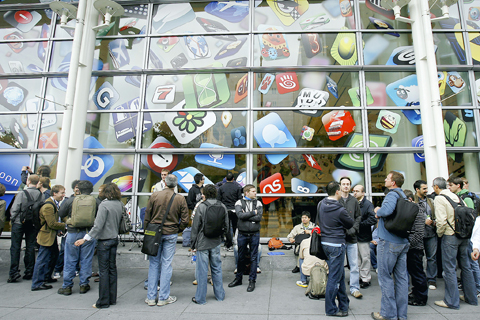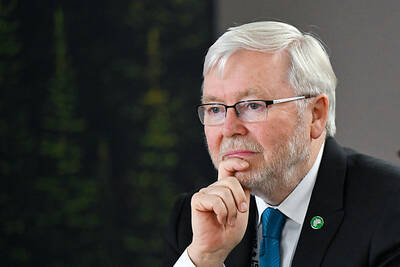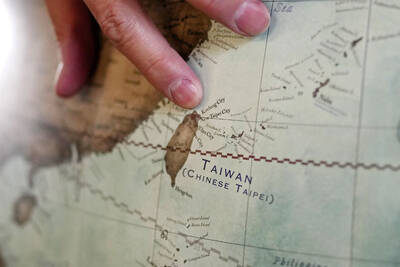Apple Inc halved the price of its entry-level iPhone to US$99 on Monday to widen the trendy device’s mass-market appeal, as global competition heats up after Palm Inc launched the Pre.
Apple also cut prices on several of its Mac notebooks amid a tooth-and-nail battle among computer makers for buyers during the recession.
And to shore up its hold on the smartphone market, it unveiled a new, faster, high-end iPhone that takes videos and has voice features, matching offerings by rivals Palm and Research in Motion’s BlackBerry.

PHOTO: BLOOMBERG
Analysts said sales could double for the cheapest iPhone.
Apple chief executive Steve Jobs, on medical leave since January, did not put in a much speculated-about appearance.
The next-generation iPhone 3GS — the “S” stands for speed, double that of the original model — goes on sale in the US, Germany and elsewhere next Friday for US$199 to US$299.
“They plugged the hole in the offering of the 3G iPhone,” Gartner analyst Van Baker said, referring to the new features.
A rambunctious crowd livened up Apple’s annual Worldwide Developers’ Conference in downtown San Francisco on Monday, whooping and applauding as executives unveiled everything from a cheaper Mac Air notebook to a new operating system.
Shares in Apple closed 0.6 percent down at US$143.85 — after a 6.5 percent climb in the week leading up to the highly anticipated event — as Jobs failed to show and investors debated the merits of the sharp iPhone price cut.
Morgan Stanley estimates that an entry-level iPhone, at what Apple marketing chief Phil Schiller calls a “breakthrough price of US$99,” could double existing sales. That is for the 8-gigabyte model previously priced at US$199.
Apple said it had sold more than 40 million iPhones and iPod Touches to date, up from the 37 million reported during a quarterly earnings call in April.
The new iPhone models and price cuts announced on Monday came days after Palm launched its Pre smartphone, which some analysts say is the iPhone’s closest rival.
Sprint Nextel Corp, which has exclusive US rights to carry the Pre, said it had record sales of the smartphone in its first weekend, and was restocking the phones “as quickly as Palm could make them.”
The US$99 iPhone will cost half as much as the US$199 Pre. By slashing the price of the 8-gigabyte iPhone and rolling models out this month, Apple’s strategy appeared designed to take advantage of the Pre’s limited availability, CL King & Associates’ Lawrence Harris said.
In a note to investors on Monday, he estimated that Palm produced just 50,000 Pre phones last month.
AT&T, the exclusive US service provider for the iPhone, will sell the 16-gigabyte 3G for US$149, down from US$299, while supplies last.
Competition is intensifying among cellphone makers from Nokia to HTC Corp for a slice of one of the few remaining fast-growth tech markets.
Globally, research house Ovum expects smartphone shipments to reach 171.9 million this year, rising 23 percent from last year to account for about 15 percent of the worldwide mobile phone market this year.
But the battle in that lucrative arena is eroding margins.
Apple executives did not comment on impact to profitability from the cheaper iPhone or Mac Air — which at US$1,499 is still costlier than computers from the likes of Dell Inc or Hewlett-Packard Co.
AT&T said the halving in price would not affect its profit targets and that it was sticking to its objective for wireless margins in the low 40 percent range.
Much of Monday’s event was taken up with new features for Apple’s best-selling gadget. Executives announced that new iPhones will support TomTom satellite navigation devices and support multiplayer games such as Asphalt 5.
The consumer electronics giant showed off a new 15-inch notebook with improved battery life, a US$300-cheaper Mac Air — its thinnest laptop — and, as expected, its highly previewed “Snow Leopard” Mac operating system software.
The company also unveiled a new 13-inch MacBook Pro starting at US$1,199, and a 15-inch laptop with longer battery life, addressing a perennial consumer concern.
Also See: [ TECHNOLOGY REVIEWS ]

NEXT GENERATION: The four plants in the Central Taiwan Science Park, designated Fab 25, would consist of four 1.4-nanometer wafer manufacturing plants, TSMC said Taiwan Semiconductor Manufacturing Co (TSMC, 台積電) plans to begin construction of four new plants later this year, with the aim to officially launch production of 2-nanometer semiconductor wafers by late 2028, Central Taiwan Science Park Bureau director-general Hsu Maw-shin (許茂新) said. Hsu made the announcement at an event on Friday evening celebrating the Central Taiwan Science Park’s 22nd anniversary. The second phase of the park’s expansion would commence with the initial construction of water detention ponds and other structures aimed at soil and water conservation, Hsu said. TSMC has officially leased the land, with the Central Taiwan Science Park having handed over the

AUKUS: The Australian Ambassador to the US said his country is working with the Pentagon and he is confident that submarine issues will be resolved Australian Ambassador to the US Kevin Rudd on Friday said that if Taiwan were to fall to China’s occupation, it would unleash China’s military capacities and capabilities more broadly. He also said his country is working with the Pentagon on the US Department of Defense’s review of the AUKUS submarine project and is confident that all issues raised will be resolved. Rudd, who served as Australian prime minister from 2007 to 2010 and for three months in 2013, made the remarks at the Aspen Security Forum in Colorado and stressed the longstanding US-Australia alliance and his close relationship with the US Undersecretary

‘WORLD WAR III’: Republican Representative Marjorie Taylor Greene said the aid would inflame tensions, but her amendment was rejected 421 votes against six The US House of Representatives on Friday passed the Department of Defense Appropriations Act for fiscal 2026, which includes US$500 million for Taiwan. The bill, which totals US$831.5 billion in discretionary spending, passed in a 221-209 vote. According to the bill, the funds for Taiwan would be administered by the US Defense Security Cooperation Agency and would remain available through Sept. 30, 2027, for the Taiwan Security Cooperation Initiative. The legislation authorizes the US Secretary of Defense, with the agreement of the US Secretary of State, to use the funds to assist Taiwan in procuring defense articles and services, and military training. Republican Representative

TAIWAN IS TAIWAN: US Representative Tom Tiffany said the amendment was not controversial, as ‘Taiwan is not — nor has it ever been — part of Communist China’ The US House of Representatives on Friday passed an amendment banning the US Department of Defense from creating, buying or displaying any map that shows Taiwan as part of the People’s Republic of China (PRC). The “Honest Maps” amendment was approved in a voice vote on Friday as part of the Department of Defense Appropriations Act for the 2026 fiscal year. The amendment prohibits using any funds from the act to create, buy or display maps that show Taiwan, Kinmen, Matsu, Penghu, Wuciou (烏坵), Green Island (綠島) or Orchid Island (Lanyu, 蘭嶼) as part of the PRC. The act includes US$831.5 billion in